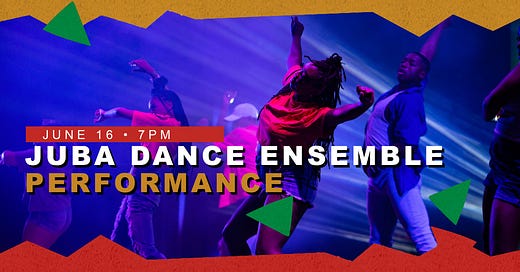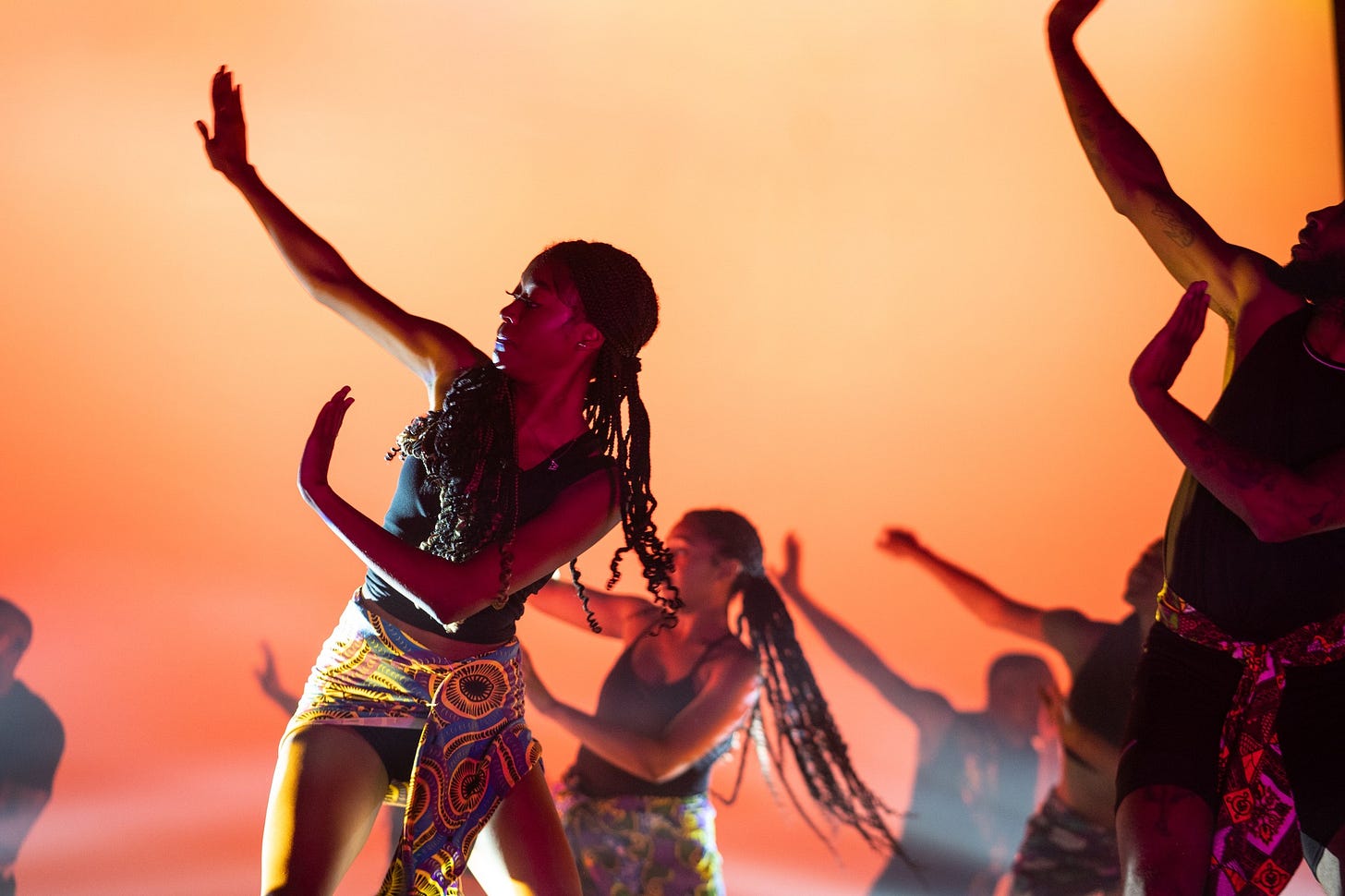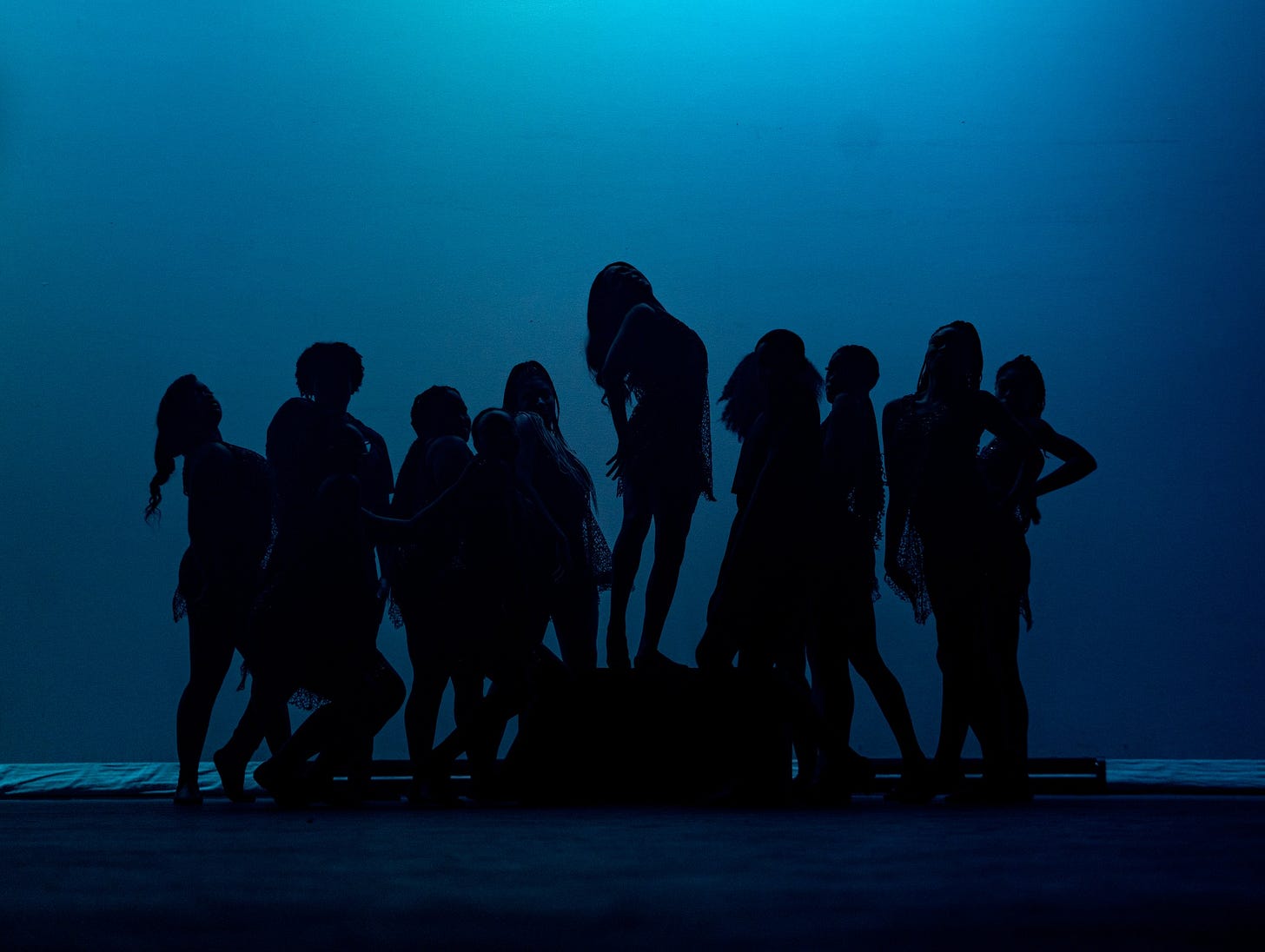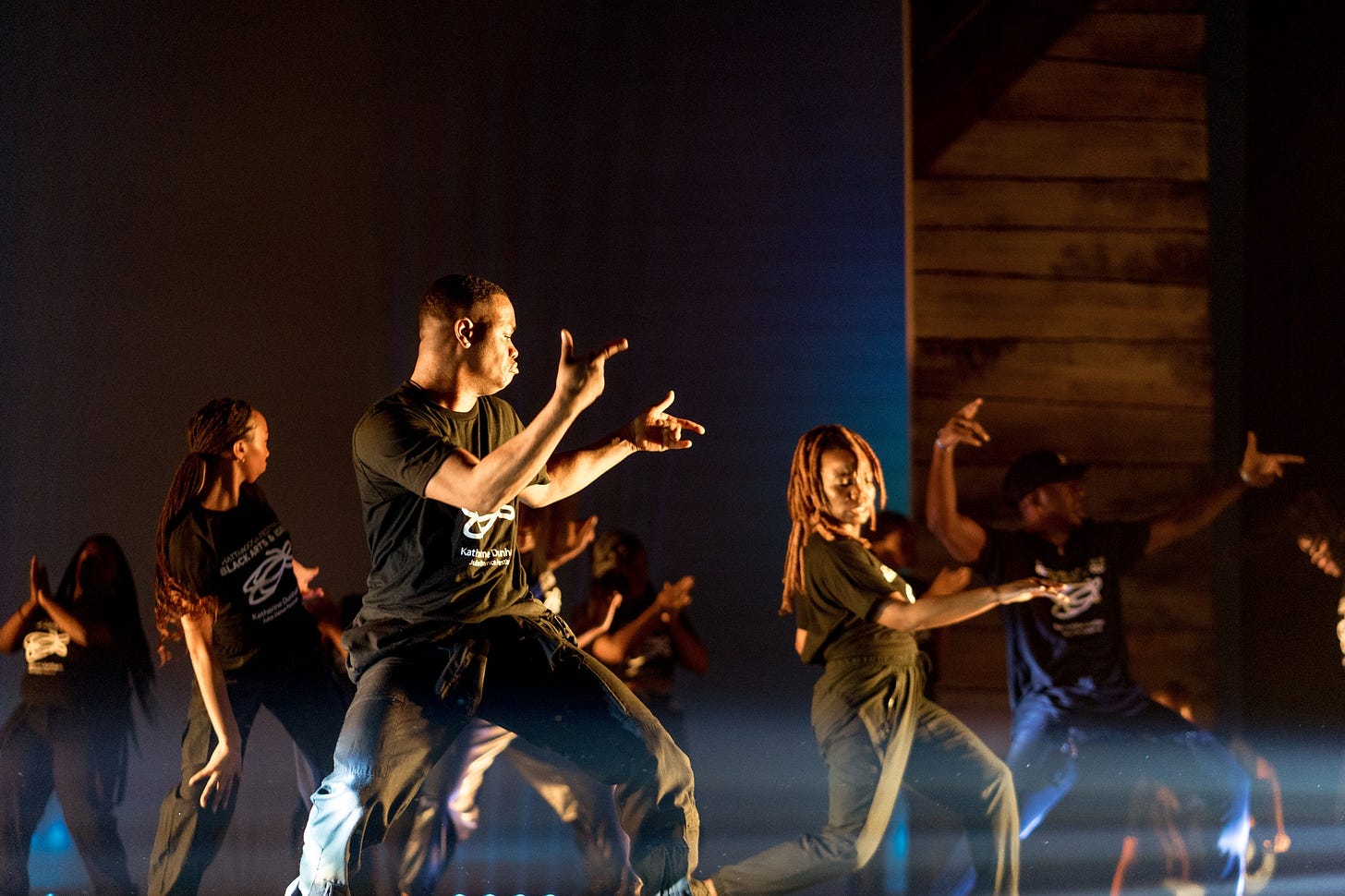Welcome!
You’re reading DanceChatt, a publication dedicated to dance writing centered in Chattanooga, Tennessee. This week we feature a review of Juba Dance Festival by dancer and teacher Monica Ellison.
DanceChatt aims to be a space where the community can share reflections about, analysis of, and plans for dance in our city. Dance-related fiction and poetry are also welcome. I’m so thankful that writers like Monica are becoming part of this project.
Please, if you feel so moved, PITCH AN ARTICLE to DanceChatt. I’m a marketing writer by training; I write to praise. That’s a good start, but it’s not enough. Read Monica’s article for a beautiful example of nuanced, precise criticism from a professional dancer. She shines light on what she sees and also what she’d like to see — an important part of elevating how we dance and how we talk about dance. We need more work like hers in DanceChatt.
Save the Date
Karen Wilson forwarded me this invitation for the dance community. Come to the party — and if you get a chance, let’s talk about conversations you’d like to see in DanceChatt.
Juba Dance Festival 2023 Review
By Monica Ellison
Photos: Chattanooga Festival of Black Arts and Ideas
I attended the Katherine Dunham Juba Dance Ensemble performance presented by the Chattanooga Festival of Black Arts and Ideas, directed by Crystal Newson, with my youngest son and one of my dearest friends. In the week or so after witnessing the event, I am left with an overwhelming sense of gratitude for two reasons.
First, my youngest son, who is a natural mover and has a deep interest in the arts, including dance and visual arts, absolutely adored the show. I am thrilled that he witnessed a stage filled with beautiful Black dancers pouring their hearts and souls into a first-class production. The production had all the elements one would desire in a show, including live music (drumming for the first piece), video footage of a documentary about the show’s namesake, Katherine Dunham, seamlessly interwoven between dances, set changes, and dynamic lighting and costumes. This was in stark contrast to the production of The Nutcracker he saw last year, which he also thoroughly enjoyed, where only a few Black dancers were involved.
The second reason for my gratitude was the personal reflection I experienced regarding my own dance journey. I am not from here, and in my hometown, the Black dance community is closely knit. I always saw Black dancers, had Black dance teachers, and knew Black dance business owners. Upon moving here, I was shocked to not see the Black presence in plain sight. I have had to search for it in a way that was not necessary in my hometown. The second reason for my gratitude circles back to my son because he was able to see this gathering of Black dancers here in Chattanooga, something that I am told has never happened in this capacity, and it is giving him a similar experience to the way that I grew up.
Enough about me, now let’s talk about the dance performance. It was stunning! The concert took us on a journey, beginning by highlighting our African roots and then showcasing ballet, modern, jazz, contemporary, and hip-hop throughout the 10 pieces. Between the dances, the audience was treated to excerpts from a documentary about the legendary Katherine Dunham, which served as both an educational experience for those unfamiliar with her pioneering achievements and a reminder of her greatness for admirers like myself.
“Welcome Home,” a joyous African dance that involved all 23 professional and pre-professional dancers, kicked off the show. It featured live drumming provided by the Yeli Ensemble, a group originally from West Africa but now based in Nashville. The choreography was a collaboration between Windship Boyd and the Yeli Ensemble. The dancers entered from the audience and the stage, filling every part of the stage and showcasing high-energy moves that required the dancers to move their whole bodies to the music, with their feet stepping in time to the drumming. Smiles were bright, and it left me wanting more.
“Escape to Afterlife,” choreographed by Crystal Newson, featured the pre-professional dancers. They danced with a great sense of maturity as they rocked their bodies side to side and executed side falls to the floor. The movements could be used in any modern dance, but with the placement of the dancers at the beginning in a pyramid-like clump with hands held together as if chained, and the hopeless manner in which they fell to the floor, it hinted at the horrors of being kidnapped from Africa and placed on a crowded slave ship. But there was a beauty to it that conveyed that the once-trapped souls on the slave ship were finally free as they made their journey into the afterlife. As the piece progressed, they transitioned into moves reminiscent of the opening piece, “Welcome Home,” symbolizing the only freedom they could experience in the afterlife.
“Drumless Soul,” choreographed by Crystal Newson, seamlessly incorporated the spoken word talents of the gifted Black creative, Erika Roberts. As Erika spoke, the dancers crossed the stage, embarking on an introspective search within themselves as they navigated their new home in America. A solitary drum stood on the stage. As the dancers moved, sometimes in agony and confusion, one of them would make their way to the drum and hit it, but it produced subdued sounds, in stark contrast to the powerful beats of the opening piece. It reminded me of our distance from our ancestral home, as its sounds were at times faint but always there within us.
“Camp Jordan” was my personal favorite performance in the first half. This trio featured Ta’sean Honeysucker, Aliyah Nelson, and Ashlee Parker, the youngest dancers of the professional company. They beautifully showcased Tarrisha Hicks’ delicate yet powerful choreography. I appreciated the nuances of the variations in the way the dancers walked as much as the big leg sweeps and lifts. There was a repeated movement where the dancers charged forward, leading with their heels as they walked, and then ending an asymmetrical shape with their bodies leaned over to one side, with the foot planted into the ground and the other leg turned in and bent at the knee with a pointed foot. The ending conveyed an essence of longing and never giving up as Ta’sean Honeysucker maintained the spiral throughout his body as he slid to the floor on one side and then made his way back up, only to do it over and over as the music ended and the lights faded.
After intermission, “Dance Break,” choreographed by Crystal Newson, changed the mood of the concert. Now we are in the present and will see the fullness of Black culture represented through dance. The piece exuded pure sassy jazz joy, with Aliyah Nelson stealing the spotlight. The entire ensemble moved with precision and energy, effortlessly transitioning between formations. Aliyah’s vivacious expressions perfectly embodied the high-energy Whitney Houston song, showcasing her exceptional range as a performer. It was a remarkable contrast to her previous performance in “Camp Jordan,” where her expressions conveyed a sense of longing and hope.
“In Diary of a Healing Black Woman,” the director took the stage for a solo turn that left the audience in awe. Unafraid to convey raw emotion, she executed trembling body movements with flawless synchronicity to the music. Her display of ballet, modern jazz technique, and the symbolic attire—a house dress with an apron—hinted at a journey of self-discovery, escaping societal constraints, and redefining her life beyond the roles of spouse and mother. The piece left room for individual interpretation, inviting each viewer to connect with their own experiences.
“Begin Again,” choreographed by creative assistant Tarrisha “Reese” Hicks, featured Crystal alongside four other women dancers. With brooms in hand, they took the stage, their intentions unclear. The piece exuded a sense of fun and liberation, possibly a depiction of a fantasy scenario or a lighthearted break from household responsibilities. Though the performance was executed flawlessly, I couldn’t help but feel a slight sense of unresolved ambiguity.
“Time to Define” presented a sultry duet choreographed and danced by Damien Kyle and Crystal Newson mesmerized everyone in the audience with its sensuality and chemistry between the dancers. Their movements exuded passion and skill and showcased the depth of their artistic expression.
“Run,” staged by Damien Kyle and danced by pre-professional dancer Owiin Merritt, tasked this young dancer with embodying the words of a Black woman shouting the obstacles faced by Black men. While still developing his skills, the dancer’s efforts were commendable, and I eagerly anticipate witnessing his growth and ability to fully embody moments of stillness in future performances.
The piece that resonated the most with both my son and myself was “Perception.” I love a piece that features all male dancers, and they really brought the intensity. Each dancer brought their unique dance background to the stage, yet they seamlessly blended together, moving in perfect harmony. The infectious energy of the piece made it impossible for my son to resist rocking his body to the rhythm. The red lighting against their black mesh shirts and black leather/vinyl-looking pants was striking.
The grand finale, “This is America,” evoked nostalgic memories of my childhood when friends and I would create dances in our neighborhood. The dancers skillfully filled the stage, flawlessly executing the hip-hop choreography by Ryan Roberts. Although initially skeptical about choreographing to a song with iconic visuals, Roberts’ distinct movement vocabulary, Crystal’s staging, and the lighting created a captivating world of its own, ending a night of amazing dance full of energy and joy.
After the final piece, a panel discussion commenced with the director and her main collaborators, providing further insight into the performance. However, I was disappointed by the absence of a bow for the dancers before the discussion. While I stayed for the panel, many audience members were unable to do so, depriving the dancers of the well-deserved standing ovation they earned. Please ensure that the dancers have the opportunity to bow when the performance is finished.
I stayed for the panel discussion and walked away with more questions than answers. Ultimately, I was left wondering why it took so long for an event like this to take place.
So, I thought back to my early days in Chattanooga, googling dance studios and not seeing a Black presence when I did so. I remember happily going to any dance performance that I found out about. As a result, I slowly began to at least know of every dance school or company in the area, particularly the Black ones, and I searched for other Black dance teachers. The Black dance leaders of this endeavor did an amazing job. It seems to me that they represent just one branch of the many branches of the Black dance community here. I wonder what could have transpired over time if all the branches of the Black dance community were knitted in the community because I know that many were missing. Maybe it’ll happen by next year, and if it does, I know that I’ll be grateful for it.
About the Performers
The Katherine Dunham Juba Dance Ensemble Presented by Chattanooga Festival of Black Arts and Ideas
Directed by Crystal Newson
Creative Assistant: Tarrisha “Reese” Hicks
Production Manager: Rob Barnett
Technical Director and Lighting Designer: Julius Johnson
Costume Stylist: Damien Kyle and Kim Reynolds
Professional Company Members: Dallas Bailey, Casey Burse, Tarrisha Hicks, Damien Kyle, Aliyah Nelson, Crystal Newson, Ashlee Parker, Matty Parker, Ryan Roberts, Lauren Anderson, Ashley Tisdale
Youth Ensemble: Cameryn Akins, Serenity Bester, Mesha Dockery, Kamiah Favors, Heiress Hayoun, Owiin Merritt, Chenoa Newell, Whitney Philips, Teryn Rodriguez, Alezah Trimble
*Ta’sean Honeysucker was listed in the dances he performed on the program but was not listed as a professional company member or youth ensemble on the program
About the Author
Monica Ellison was born and raised in Baltimore. She lives in Chattanooga, TN with her husband and their three boys. Since 2021, she has rededicated herself to dancing for herself by dancing every single day. You can follow her own instagram at createyourdancelife.
Join the Chatt
I hope you enjoyed this dance essay. Keep reading for Q&A articles featuring new leaders and long-time supporters in the Chattanooga dance scene.
Join the conversation! If you’re interested in writing for DanceChatt, send a pitch email to jennelisewebster@gmail.com.
Until then, keep dancing!
— Jenn








